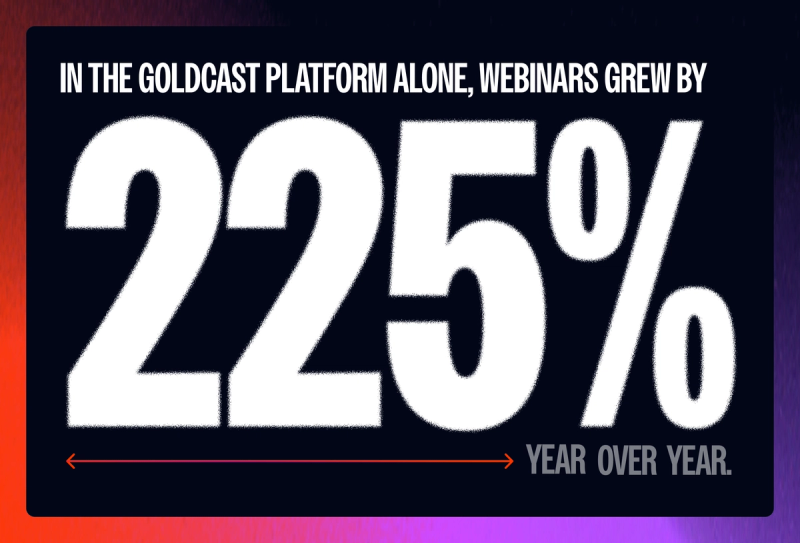3 Top Insights From the 2025 B2B Webinar Benchmark Report

Table of Contents
Maximize Your Marketing ROI
Join 10,000 other marketers already getting the best tips on running engaging events that boost pipeline and create raving fans.
Our brand-new 2025 B2B Webinar Benchmark Report is hot off the press, and we're beyond ready to discuss it with you.
First, can we just talk about how much data there was to analyze this year?! We parsed through 19,531 webinars across 418 B2B companies — a 225% and 39.9% increase from 2024, respectively!
With that much info, we were able to make some clear comparisons between last year's and this year's numbers. We also discovered some new-to-us tidbits, like pinpointing the exact time windows that work best for webinar scheduling, broken down by industry 👀
Want the full scoop?
Check out all of the juicy details in this year's B2B Webinar Benchmark Report!
Read on for some of the most intriguing discoveries we made this year. You can also download the full report and follow along as we go!
Insight #1: We're in the middle of a webinar gold rush
Much like the crowds of people who flocked to the West hoping to discover gold, folks are coming to webinars in droves — and companies are hosting more as a result.
We've already discussed how there were more than 19,000 webinars last year, representing a 225% increase YoY.

But there were also big leaps in the number of registrants and attendees:
- Registrants: 1.7M → 3.5M = 106% jump
- Attendees: 613K → 815K = 33% increase
Remember in the early days of virtual events, when hosting one webinar a month felt ambitious? When we launched this report in 2021, companies were averaging about 13 webinars a year.
Fast forward to now, and we're clocking an average of 47 webinars a year — that's almost one a week.
Webinar frequency:
2021: 13 webinars/year
2023: 22 webinars/year (69% increase)
2024: 47 webinars/year (113% increase)
Driving forces of webinar growth
Webinars have become core components of the B2B content marketing engine, and they're not going anywhere.
There are many reasons for this. We dive into this more fully in the report, but here are just a few:
- Growing demand for video content: People can't get enough video, and webinars are one of the best ways for B2B brands to produce compelling videos at scale.
- The rise of AI: We can't talk about scaling without mentioning AI! It's now easier to produce events and get the most runway out of content.
- Broader use cases: Webinars aren't an hour-long sales pitch anymore. They're now being used for internal meetings, training, product demos, customer education, and so much more.
It's clear that companies who aren't investing in webinar programming need to get busy catching up. Webinars not only allow you to get more runway out of your events, but they also help you build Mindshare so you're on people's minds when it's time to purchase.
Insight #2: AI-powered content repurposing has taken off
If those webinar numbers just made you look twice, you might want to strap in before we get into the repurposing stats.
We'll give you a second to get ready while we talk about why repurposing is such a good idea.
To put it bluntly: You've already put in a bunch of time, effort, and resources to come up with a great webinar idea and then execute on it. Repurposing just lets you get even more runway out of that investment, after the event is over.
Content repurposing is critical for extending webinar value and maximizing your return.
Here are some key benefits of repurposing:
- Reach bigger audiences across different platforms
- Reinforce your key messages over time
- Accommodate different content consumption preferences
- Save time and money
Alright. Let's talk hard numbers!
Total assets created in Content Lab in 2024: 226,006
Total assets refers to anything produced in Content Lab, from videos to takeaway posts to email drafts. Last year, we shared some specific numbers around video clips, text assets, and formats. Here we'll look at video and text assets, year over year.
Total video clips created:
- 2023: 4,371
- 2024: 131,296 (a 2,903% increase!)
Total unique text assets created:
- 2023: 819
- 2024: 94,710 (an 11,464% increase!)
Pretty astronomical growth, right? We love that marketers have wisened up to the fact that repurposing lets you get so much more out of every event, without having to add overhead costs.
Content Lab is 100% free
Upload one hour to Content Lab each month for free! Start repurposing today and get the most from your webinars.
What's causing the surge in repurposing?
As you can see, folks are using Content Lab to create way more video clips and text assets than ever before.
But the type of assets they're creating has also changed — for example, last year, the top text asset created was blogs, and this year it's, well, something different (you'll have to head to the report to find that out 😉).
Across the B2B industry, there's been a massive transition from singular-event thinking to viewing webinars as content machines. Webinars are now understood to be not only a way to connect with audiences and create Mindshare, but the best route to produce enough material to fuel a lasting, comprehensive content strategy.
Insight #3: Scheduling best practices vary by industry
This year's research revealed some new patterns around optimal webinar timing. We realized that the "best" time to schedule your webinar sometimes depends largely on your industry.
Tech vs. non-tech industries
The overall attendance rate for all non-segmented webinars is 33%, but certain day and time slots significantly outperformed this benchmark.
- Average overall attendance rate: 33%
- Tech companies: Friday 12-3 PM achieves a 44% attendance rate
- Non-tech companies: Friday 9 AM-Noon achieves a 54% attendance rate
For tech companies, the best time for high attendance was on Friday, starting at lunchtime, while non-tech companies enjoyed a higher attendance rate on Friday mornings.
This is an interesting finding because we also know the majority of webinars don't happen on Friday. It's possible that going against the grain and scheduling on Friday can pay off, depending on your audience.
Industry-specific timing
When we drilled down into more specific industry data, we saw a lot of variations in the "golden hour" for different types of companies. Here are just two examples:
- Manufacturing: Friday 6-9 PM, Monday 9 AM-Noon
- Finance: Monday 6-9 PM
You probably wouldn't have guessed that late Friday evenings would be a prime time for webinar attendance — or maybe we just weren't aware of that because we don't work in the manufacturing industry! Either way, if you're in manufacturing or finance (or one of the other industries we include in the report), these peak times build a strong case for scheduling outside of the generally recommended days and times.
Want more insights? Download the full 2025 B2B Webinar Benchmark Report!
We've presented just three of the data points covered in this year's report. Overall, we're continuing to see webinars evolve from one-and-done meetings to part of the foundation of modern B2B marketing.
We encourage you to review the entire report. In it, you'll find the following:
- Your very own Webinar Benchmark Scorecard, so you can find out how you stack up against other companies
- A surprising reversal on how people feel about webinars that are called "webinars"
- Which days of the week generally bring the highest attendees in
- The average number of speakers per webinar event
- …and more!
Want all the insights?
Access the full analysis and all of our new findings in the 2025 B2B Webinar Benchmark Report.
Transform Your Video Marketing with AI
Stay In Touch
Platform
Resources
© 2025 Copyright Goldcast, Inc. All rights reserved.





 Upcoming Events
Upcoming Events Event Series
Event Series On-Demand Events
On-Demand Events

